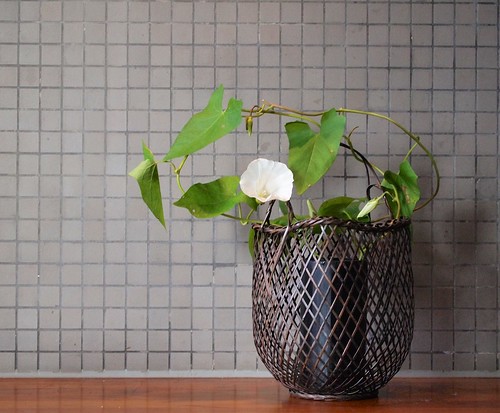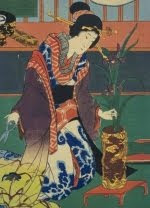Morning glory / Large bindweed (Calystegia sepium).
Naturalistic freestyle.
The flower of the Morning glory opens early in the morning and lasts for one day only. Not a very long-lasting friend in other words, but for this very reason it is a favored flower by tea masters. The ideal flowers for a tea ceremony are the ones that you pick very fresh the same morning, and that lasts a few hours until the ceremony is over. It's a quality that goes well with the experience of catching the moment and being here and now.
Morning glory was first known in China as a medicine plant. It was introduced to Japan in the 9th century. The Japanese where the first to cultivate it as an ornamental flower, and have been leading in developing varieties.
I picked these flowers a couple of weeks ago, really late in the season. In Japanese horticulture and art the Morning glory has come to symbolize summer. My flowers are a wild species named Large bindweed, Calystegia sepium. They grow wild in parts of Norway and are not to be panted in gardens as they are very invasive. Next time I will make sure to also pick an end part of these long creepers, so that I can add an open line going out of the circular movement. That would give an even more poetic result, I think.
One of the most famous stories about the tea master Rikyu involves Morning glories. Lord Hideyoshi had heard about the beauty of Rikyu’s blooming Morning glories and announced that he would come and see them. When he arrived, however, not a single Morning glory was to be seen in the garden, but only the stubble of their stalks left in the garden. The lord was terrifically displeased. When he entered the tearoom, however, he found one splendid morning glory, fresh and radiant, arranged in a vase in the alcove. The lord and his attendants felt suddenly refreshed, as if they had just awakened (as told on the website zencha.org).
Naturalistic freestyle.
The flower of the Morning glory opens early in the morning and lasts for one day only. Not a very long-lasting friend in other words, but for this very reason it is a favored flower by tea masters. The ideal flowers for a tea ceremony are the ones that you pick very fresh the same morning, and that lasts a few hours until the ceremony is over. It's a quality that goes well with the experience of catching the moment and being here and now.
Morning glory was first known in China as a medicine plant. It was introduced to Japan in the 9th century. The Japanese where the first to cultivate it as an ornamental flower, and have been leading in developing varieties.
I picked these flowers a couple of weeks ago, really late in the season. In Japanese horticulture and art the Morning glory has come to symbolize summer. My flowers are a wild species named Large bindweed, Calystegia sepium. They grow wild in parts of Norway and are not to be panted in gardens as they are very invasive. Next time I will make sure to also pick an end part of these long creepers, so that I can add an open line going out of the circular movement. That would give an even more poetic result, I think.
One of the most famous stories about the tea master Rikyu involves Morning glories. Lord Hideyoshi had heard about the beauty of Rikyu’s blooming Morning glories and announced that he would come and see them. When he arrived, however, not a single Morning glory was to be seen in the garden, but only the stubble of their stalks left in the garden. The lord was terrifically displeased. When he entered the tearoom, however, he found one splendid morning glory, fresh and radiant, arranged in a vase in the alcove. The lord and his attendants felt suddenly refreshed, as if they had just awakened (as told on the website zencha.org).













1 comment:
I found a very nice example of a Morning glory arrangement on a Japanese ikebana blog. Please have a look - it is very elegant:
http://nageire.exblog.jp/22630611/
Post a Comment